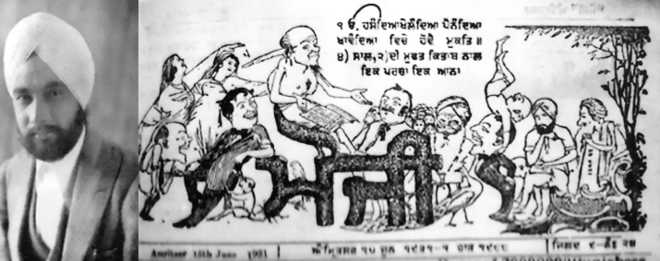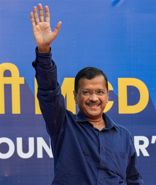
of those times: A young Sobha Singh; (left) an illustration that appeared in Mauji in June, 1931
Jasbir Singh Bhatia
Around two decades ago, as a PhD student researching Sikh portrait painting at Punjabi University, Patiala, I came across a rather curious comic strip. It stood right there on the top panel of a newspaper named Mauji. Modelled after the English weekly Punch, Mauji was a satirical and humour magazine. It was not the magazine that intrigued me, but the maker of that comic strip, Sobha Singh. Here was a completely unknown facet of a man revered because of his paintings of Sikh Gurus and folk legends.
The legendary painter shot to fame post-Partition, but long before that he was an illustrator. Ever since he was young, Sobha Singh was interested in sketching, which is why he didn’t study much. He joined the British army as a draughtsman and spent a few years in Burma too. However, as he didn’t quite like the restricting military life, five years later, he resigned from the army and returned to Amritsar in 1921.
The nearby city of Lahore was the centre of all cultural and literary activities in those days; and Amritsar wasn’t far behind. Sobha Singh came into contact with some progressive writers associated with the freedom struggle.
While he had a studio there, he also began making illustrations to accompany the write-ups and stories by these writers that would appear in various magazines. Prominent among these were Ranjit Nagara, Phulwari, Desh Sewak, Akali Lahore, Akali Patrika, Pritam and Panch.
The illustration accompanying this piece appeared in Mauji, which was published from Amritsar. Dotted with motifs like a monkey and a peacock, it portrays the British gentry, along with a figure that appears like Lenin, having a nice time. To the extreme right are two figures that resemble Sohan Singh Josh and Baba Waryam Singh, who were leading the Akali movement around that time, sitting sullen. Right underneath that is written, in English, the name of the illustrator, Sobha Singh. The paper bears the date June 15, 1931.
In this work, it is obvious that before us is an artist of sensibility and sensitivity, conscious of its political and social implications and its economic undercurrents. While a few of his works, including those on Bengal famine and the Partition of India, are in public domain, his role as a cartoonist is not much known.
As I was researching Sikh portrait painting at the reference library at Punjabi University, I came across several newspapers from that era that carried illustrations and cartoon strips by Sobha Singh. These early works by the artist were realistic and modern. He later shifted to Andretta in Himachal Pradesh where he adopted European style of painting. It was then that he began to gain fame.
— As told to Sarika Sharma



























